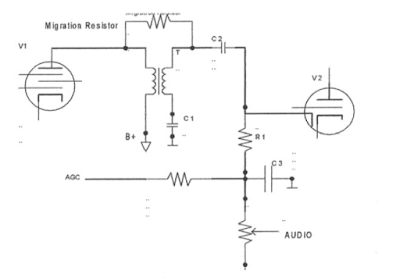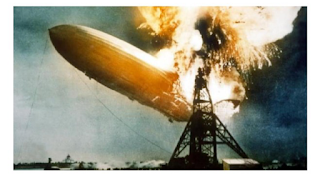Miniature First IF Transformer
By Bill Jones
These miniature transformers may cause a problem because of their built in tuning capacitors. The capacitors in question normally have a value in the order of one hundred pico-farads. They are constructed on one small piece of mica that is slightly smaller than the I.F. transformer base, and the capacitors are in the base of the transformer. The mica is silver plated on each side and the silver is placed on the mica to form two capacitors, one for the primary of the transformer, and one for the secondary. One edge of each of the capacitors is physically close to each other. Tuning for these transformers is accomplished by means of a ferrite slug. Because of factors that are not clear, some radios that have this type of capacitor will be found to have a silver migration from one capacitor to the other capacitor forming what I call a “migration resistor”. The resistor is unstable and causes a radio to be very noisy. I would guess that the formation of the migration resistor is due to the voltage between the primary and secondary along with other factors – such as humidity and perhaps other elements such as sulphur in the air. The problem may only be present in transformers made by certain manufacturers, but I do not have enough data to confirm such suspicion.
I do find a number of radios that use the miniature I. F. transformer to have this resistor between the primary and the secondary of the transformer. This resistance is usually in the range of one to twenty megohms and the radio is quite noisy even when the resistor is in the order of twenty megohms. The resistor can cause the radio to be noisy at times, but the radio may work perfectly at other times. I also find radios that will not work at all because of the migration resistor.
This resistance will provide a positive bias on the grid of the first I.F. and the bias may be as high as two volts (or more) if the first I.F. tube has a cathode resistor. The second I. F. may also be bad, but the voltage on the diode detector that is caused by the transformer will not be as large as the grid bias caused by a bad first I.F. transformer. With no I.F. signal present there will be a small positive bias on the detector diode plate if there is a migration resistor problem. This voltage value will normally be to less than six tenths of a volt.
The I.F. signal itself will, in a properly operating radio cause the diode to conduct very slightly on the positive peaks of the signal and the diode acting as a rectifier will provide a negative voltage on the diode plate. To determine if there is a migration resistor present may be difficult but there are several ways to check this. One easy way is to remove the wire going to the diode detector plate and measure the voltage on the secondary of the I.F. transformer. The voltage should be close to zero and not positive. Another means is to short the grid of the second I.F. tube to ground and if the noise is still present the problem may very well be the transformer.




Comments
Post a Comment